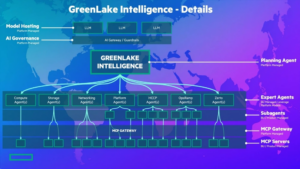
HPE Moves Into Agentic AIOps with GreenLake Intelligence

GreenLake Intelligence helps IT teams manage operations (Image courtesy HPE)
HPE today launched GreenLake Intelligence, a new AI-powered framework designed to proactively monitor IT operations and autonomously take action to prevent problems before they arise. The company, which made the announcement at its annual HPE Discover conference in Las Vegas, says the shift to agentic AIOps will alleviate the burden on human administrators and operators while still keeping them in the loop.
Organizations today are struggling to monitor and control the vast array of servers, storage, networks, operating systems, databases, and applications that they rely on to deliver digital services to their customers. Traditional monitoring tools have long since been overwhelmed by the tsunami of observability data flowing off these systems, which led directly to the reliance on machine learning techniques to detect abnormalities, which led to the AIOps era.
But the volume of observability data has continued to grow unabated, and now the AIOps and observability tool vendors are becoming overwhelmed. In some situations, the size of companies’ observability data rivals the enterprise data that actually drives their business. To address this situation, some companies are turning to agentic AI to not only monitor IT operations but to mimic human responses to them.
This is the path that HPE is taking with GreenLake Intelligence, which is one of several announcements HPE made at its Discover conference today. GreenLake Intelligence is a new offering under HPE’s GreenLake Copilot that automatically deploys AI agents to monitor an array of server, storage, networking, and virtualized resources, including customer IT resources developed by HPE as well as third-party gear, running either on prem or in the cloud.
GreenLake Intelligence is based on a domain-specific large language model (LLM) that’s trained on HPE’s telemetry, logs, configurations, and support data. It also includes an array of various agents that use Model Context Protocol (MCP) to coordinate with each other through an “agentic mesh.”
“We are building Greenlake agents with the situational awareness they need to make intelligent decisions based on real-time infrastructure metrics and business logic,” writes Brian Gruttadauria, the CTO of HPE’s hybrid cloud/AI business in a blog post. “Whether you’re attempting to retrieve data from an HPE Alletra Storage MP X10000 storage array or provision a Kubernetes cluster for a mission-critical application, or understand the experience of a user on Wi-Fi, the agents orchestrate to deliver on the task requested.”
The use of MCP enables the agents to communicate with each other, calling in additional agents to solve AIOps challenges when the need arises. For instance, if an agent detects anomalous behavior in financial data, it can request enhanced resources from another agent responsible for dynamic workload orchestration, HPE says.
GreenLake Intelligence will help overworked IT teams by shouldering some of the operational burden, HPE says. The copilot will help teams to keep things straight in increasingly complex hybrid cloud deployments, and also assist with root cause intelligence, the company says. In short, it will serve as the connective tissue between human operators and the systems they control by enabling natural-language interactions, providing contextual insights, and providing recommendations.
“HPE is reimagining hybrid IT as only we can do, catapulting organizations from the era of hybrid complexity to the era of agentic-AI-powered cloud operations,” stated HPE President and CEO Antonio Neri. “HPE’s new vision for hybrid IT is fueled by agentic intelligence at every layer of infrastructure, so enterprises can realize their boldest ambitions and achieve previously impossible levels of IT operations performance and efficiency.”
Related Items:
Decoding Metrics: Why Observability’s ‘Universal Language’ Still Needs Translation
2025 Observability Predictions and Observations
Explosion of Observability Data from Cloud Reaches Tipping Point, Dynatrace Says



























